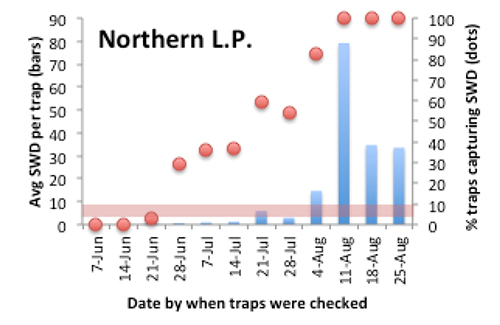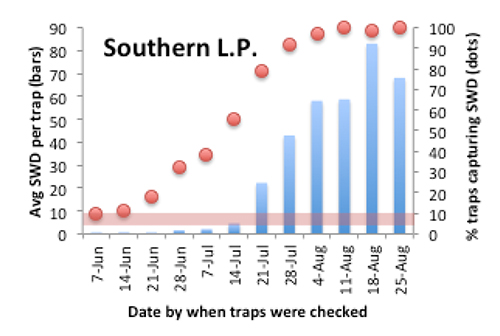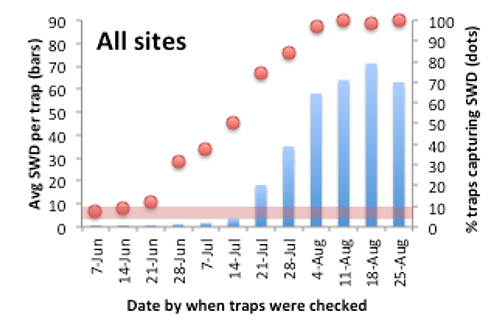Michigan spotted wing Drosophila report for Aug. 26, 2016
High risk of infestation of fruit continues to be expected. Susceptible crops must be protected. This is the final SWD report of 2016.
This is the final report of the Michigan State University Extension spotted wing Drosophila (SWD) Statewide Monitoring Network for 2016. Out of the 48 traps collected during the week prior to Aug. 25, we captured a total of 1,595 female and 1,432 male SWD for a total of 3,027 SWD flies. We found an average of more than 60 SWD flies per trap and captured them in all traps being monitored this week. Ripening fruit throughout the state must be protected or risk infestation, including late season blueberry, grape, peach and raspberry.
Through the end of the growing season, we expect SWD populations to continue to grow and the potential for damage to be very high in remaining susceptible crops – especially given cooler nights and less extreme daytime heat. The conditions are highly conducive to its development, and we expect shorter generation times and greater survival of flies with the moist conditions and more moderate temperatures.
The regions that are being monitored for SWD in 2016, how each region is defined (by the counties listed), the number of sites in each region that were monitored this week, the cumulative total of SWD flies caught in traps by region, and the average number of SWD flies caught per trap. | ||||
|---|---|---|---|---|
|
Region |
Counties covered in the SWD monitoring network |
No. sites this week |
Cumulative SWD Total |
Avg. SWD flies per trap for the week ending Aug. 25 |
|
SE |
Genesee, Ingham, Lenawee, Livingston, Macomb, Monroe, Oakland |
14 |
5,324 |
62.6 |
|
SW |
Allegan, Berrien, Kalamazoo, Ottawa, Van Buren |
21 |
17,774 |
84.5 |
|
Ridge |
Ionia, Kent, Muskegon |
5 |
992 |
23.6 |
|
WC |
Mecosta, Oceana |
1 |
225 |
23 |
|
NW |
Antrim, Benzie, Grand Traverse, Leelanau, Manistee |
7 |
3,124 |
33.6 |
|
Grand Total: |
48 |
27,439 |
63.1 |
|
Some growers have had a hard time controlling SWD this season. Short application intervals and reapplication after rain events – being sure to check product labels for reapplication restrictions and season maximums – are critical to managing this pest. Check with local Extension staff or crop consultants, and refer to the MSU Fruit Pest Management Guide for recommendations for your crop(s).



Bars represent the average number of SWD flies caught in monitoring network traps each week. Dots represent the percent traps that captured SWD that week. The shaded bar across each graph represents the proposed threshold for triggering management of the pest in susceptible crops. Northern L.P. encompasses all network traps in counties north of and including Clare in the Lower Peninsula (n = 7 traps this week). Southern L.P. encompasses all network traps in counties south of Clare in the Lower Peninsula (n = 41 traps this week).
Traps in the network are baited with commercially available lures and placed in susceptible crop fields or orchards – or in a location adjacent to susceptible crops – in areas where SWD infestation has been recorded in the past. Commercial plantings included strawberry, blueberry, raspberry, grape, tart and sweet cherry, peach and plum. Counties included in the 2016 trapping network are Allegan, Antrim, Benzie, Berrien, Genesee, Grand Traverse, Ingham, Ionia, Kalamazoo, Kent, Leelanau, Lenawee, Livingston, Macomb, Manistee, Mecosta, Monroe, Muskegon, Oakland, Oceana, Ottawa and Van Buren.
For the most current recommendations for monitoring this pest, please refer to “Monitoring traps for catching spotted wing Drosophila.” You can find out more about how to identify and manage this pest in fruit crops by visiting MSU’s Spotted Wing Drosophila website.



 Print
Print Email
Email



